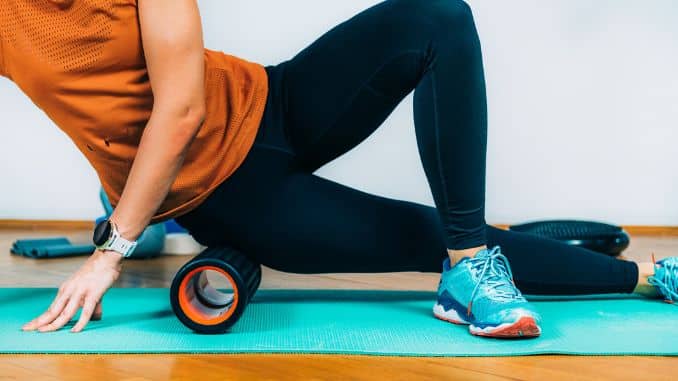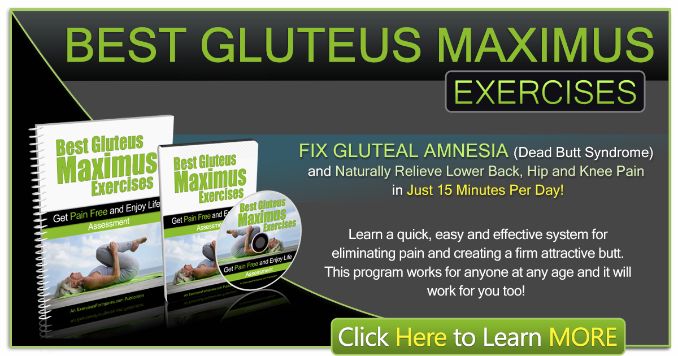Medical Disclaimer: The information in this blog is for enlightening and educational purposes only and is not intended as medical advice. The content in this post is not meant to substitute for a professional medical diagnosis, advice, or treatment. Always ask advice from your physician or other qualified health providers with any questions you may have regarding a medical condition.
If you’re dealing with tight hips and sore glutes, foam roller exercises for hips and glutes are your go-to solution! This easy yet effective technique also targets muscle knots, eases pain, and boosts flexibility, helping you move more freely and feel great.
Wave goodbye to stiffness and say hello to smoother, pain-free movement! Ready to feel the difference? Moreover, let’s explore how foam rolling can take your hip and glute health to the next level—no more waiting around!
If you want to improve hip flexibility [1], using a foam roller on your hamstrings before stretching is a good idea, especially if your flexibility is limited and you’re not injured. Additionally, this helps improve hip movement the most.
Benefits of Using Foam Rollers
- Foam rolling reduces hip pain [2] in osteoarthritis patients and offers more relief compared to those who don’t use it.
- Foam rolling increases joint range of motion and reduces pain after exercise, making it helpful for regular workouts.
- Moreover, foam rolling relieves pain in people with hip osteoarthritis and lower back pain while also enhancing flexibility and muscular performance.
- Foam rolling reduces muscle tension and may lower injury risk by improving muscle recovery and relaxation.
- Foam rolling speeds up recovery after exercise by reducing soreness and improving lymphatic drainage.
- Foam rolling may temporarily reduce muscle tightness and ease tension in connective tissue around the lower back.
Foam Roller Exercises for Hips and Glutes
1. Foam Rolling the IT Band (Iliotibial Band)
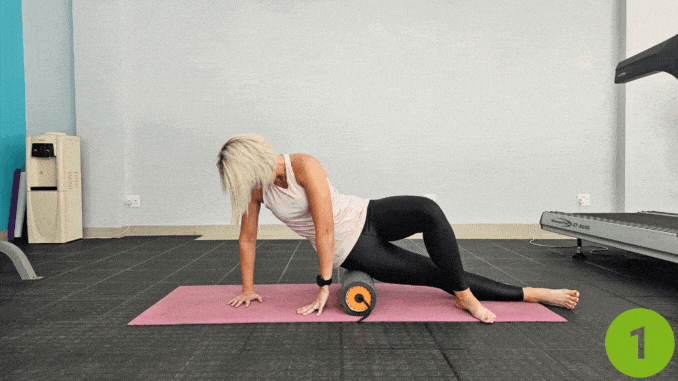
Benefits: This targets the hip flexors, helping release tension in the front of the hip.
- Begin in an upright sitting position on the floor with your legs extended in front of you.
- Then, place a foam roller just below your hip (on the outer thigh). The leg you’re rolling should be straight.
- Cross your top leg over and place that foot flat on the floor for support. Engage your core muscles.
- Use your hands and the opposite foot to support your weight.
Slowly roll down the side of your thigh toward the knee. Do not roll over the knee joint. - Moreover, move in small sections, pausing on tender areas for 20–30 seconds.
- Repeat the movement on the opposite side. Spend no more than 1–2 minutes per side.
Notes:
- Use your arms and top leg to control pressure. Additionally, the IT band can be sensitive.
- If the pressure is too much, roll slightly forward or backward to target adjacent muscles (TFL, vastus lateralis).
2. Foam Rolling the Glutes:
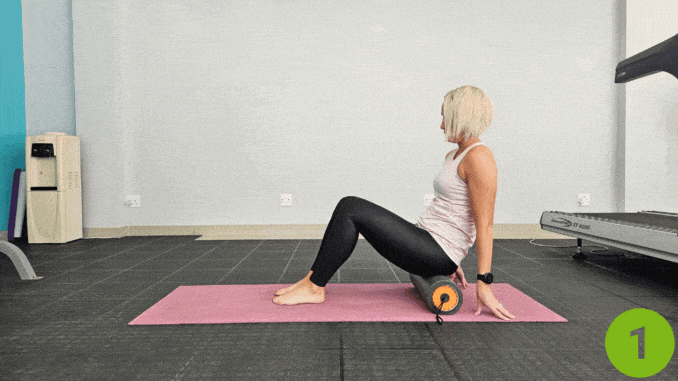
Benefits: This exercise targets the glutes, helping to release tightness and improve mobility.
- Begin in an upright sitting position on the floor with your legs extended in front of you.
- Then, place the foam roller just under your glutes.
- Place your hands behind you on the floor for balance.
- Cross one ankle over the opposite knee to form a figure-four position, which will help open up the glutes.
- Engage your core muscles.
- Shift your weight slightly to one side and use your hands for support on the floor.
- Moreover, hold on to any tight spots for a deeper release.
- Move in small sections, pausing on tender areas for 20–30 seconds.
- Repeat the movement on the opposite side. Spend no more than 1–2 minutes per side.
3. Foam Rolling the Hip Flexors:
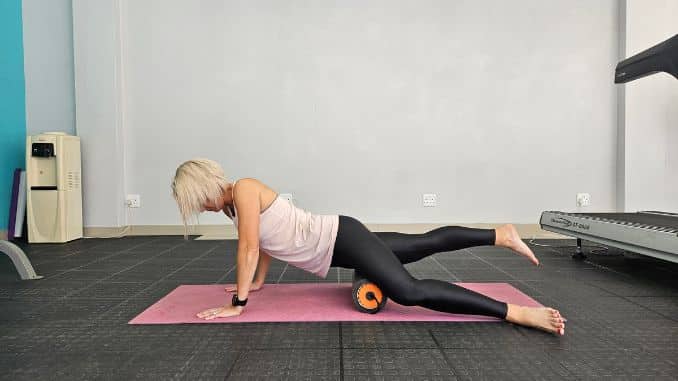
Benefits: This helps release tightness in the front of the thigh, which can affect both the hip and knee area.
- Begin in a forearm plank position with your body aligned and your core engaged.
- Then, place the foam roller along the outer thigh, starting just below the hip.
- Shift your weight slightly forward and engage your core muscles,
- Moreover, roll back and forth, moving from your hip area down toward your lower belly.
- Focus on tight or tender spots by pausing for up to 10–15 seconds.
For added pressure, adjust your body angle or lean forward slightly. Additionally, this exercise targets the hip flexors, helping release tension and improve flexibility in the hip area.
4. Foam Rolling the Hamstrings:
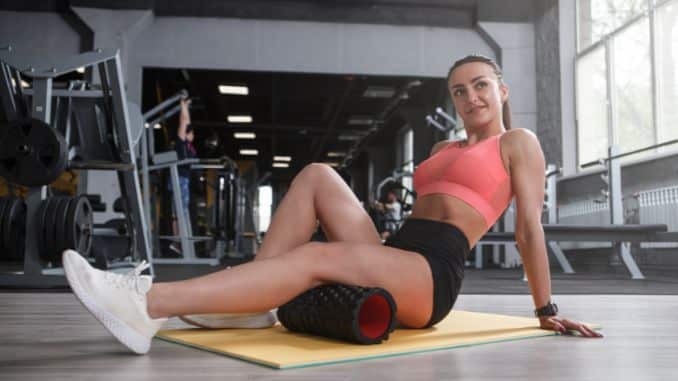
Benefits: This targets the hamstrings but can also help alleviate tension around the hips.
- Begin in an upright sitting position on the floor with your knees bent and feet flat on the floor.
- Maintain good alignment with your upper body.
- Then, straighten one leg and place the foam roller under your thigh.
- Place your hands at the back for support as you lean back to increase the angle of your body.
- Engage your core muscles. Slowly move the roller along the length of your hamstrings.
- Moreover, repeat the movement 10 times.
- Relax and repeat the movement on the opposite side.
5. Foam Rolling the Lower Back (Thoracolumbar Fascia):
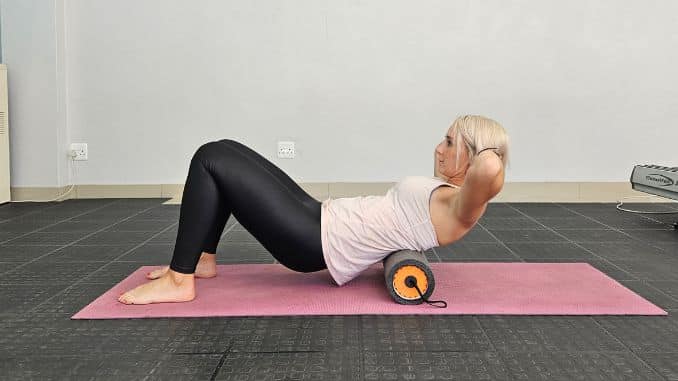
Benefits: This can release tension in the surrounding muscles and fascia, helping with hip and lower back mobility. Avoid rolling directly on the spine; instead, focus on the muscles on either side.
- Begin by lying on your back with your knees bent and feet flat on the floor.
- Then, place the foam roller under your lower back, just above your hips.
- Then, support your head with your hands and gently lift your hips off the ground.
- Engage your core muscles.
- Moreover, slowly roll back and forth along the lower back and the sides, focusing on the muscle areas rather than rolling directly on your spine.
- Moreover, repeat the movements with 10 repetitions.
You can adjust the movement to target specific areas of tension. Additionally, this exercise helps release tightness in the lower back and thoracolumbar fascia, improving flexibility and reducing discomfort.
Common Mistakes to Avoid
- One of the most common mistakes to avoid when foam rolling is applying too much pressure, which can cause discomfort and injury.
- It’s also important to avoid rolling over bony areas, such as the knees and ankles, and to focus on slow and controlled movements to target tight muscles and connective tissue.
- Moreover, don’t forget to breathe deeply and slowly while foam rolling, as this can help alleviate tension and improve overall relaxation.
- Regularly cleaning and maintaining your foam roller can also help prevent the spread of bacteria and other microorganisms.
Conclusion and Next Steps

Foam rolling is a game-changer for muscle pain and flexibility, making it the perfect addition to your routine. It helps reduce soreness, boosts muscle health, and increases mobility, so you can move better and feel great.
Start slow, gradually adding pressure, and focus on controlled movements to target tight spots. With regular use, foam rolling can improve your flexibility [3], reduce discomfort, and enhance your overall well-being!
If you want to improve the activation, endurance, and strength of your gluteus maximus, click here to grab your copy of the Best Gluteus Maximus Exercises program.
Frequently Asked Questions
What’s the Best Foam Roller to Use?
According to Doctor Jo, the Muscle Mauler Max foam roller is great for easing pain and swelling in your hips and glutes. The raised bumps on the roller act like mini pressure points for a deeper massage. It’s perfect for preventing injuries and loosening tight muscles—just roll gently over the sore areas.
Do foam rollers work for hips?
Foam rollers can help relieve tightness in the hip area by applying pressure to muscles and connective tissue. Moreover, they may help improve flexibility and reduce discomfort, but results can vary from person to person.
How do you release tight hips with a foam roller?
To release tight hips, you can roll gently over the hip flexors, glutes, and outer thigh area. Moreover, focus on areas that feel tight, and pause on any sore spots for a few seconds. Make sure to use slow and controlled movements to avoid injury.
Is a foam roller good for your glutes?
Yes, foam rolling is highly effective for the glutes. It helps reduce muscle tension, improves flexibility, and can ease soreness from exercise or prolonged sitting. Moreover, incorporating foam roller exercises for hips and glutes regularly helps maintain glute health and prevents tightness in the surrounding muscles.
Is it better to foam roll in the morning or at night?
There isn’t a strict rule. Some people prefer morning foam rolling to loosen up and prep the body for the day, while others enjoy it at night to unwind tight muscles before bed. Whichever time you choose, consistent foam roller exercises for hips and glutes can significantly improve how your body feels and functions.

